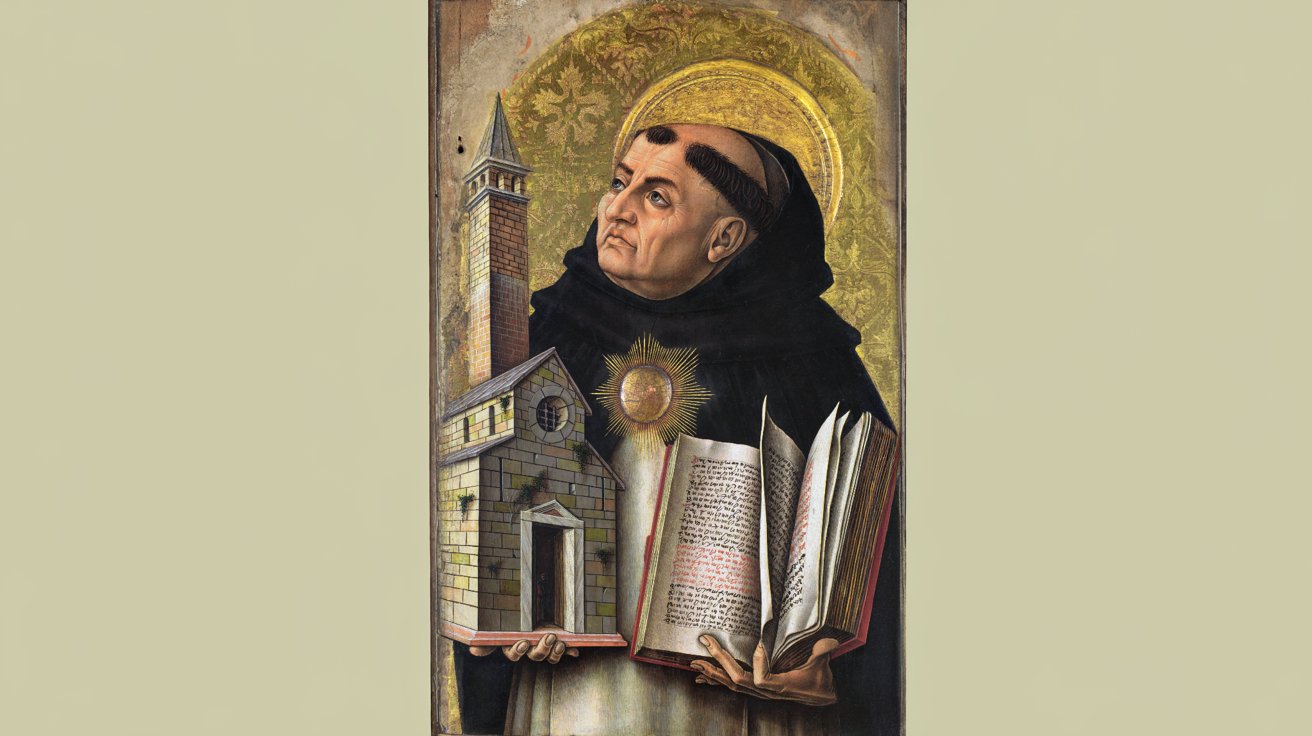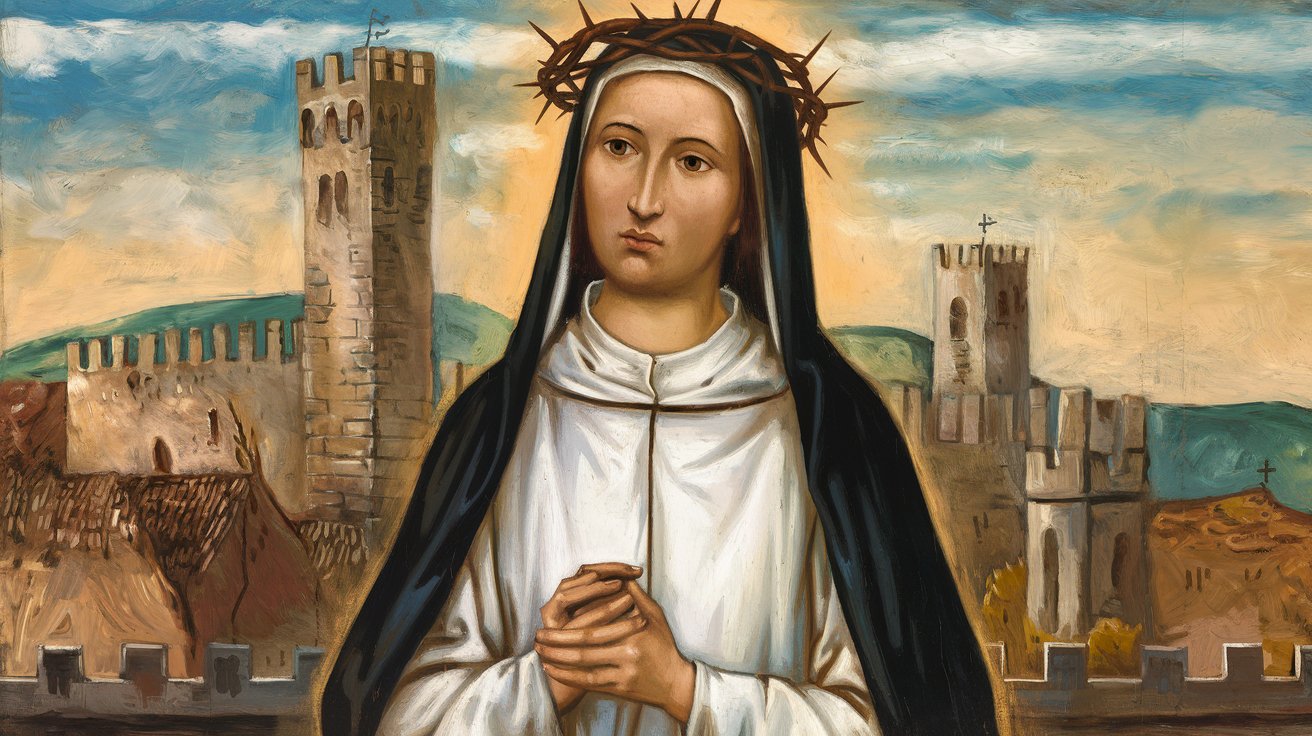Early Life and Background
Thomas Aquinas was born around 1225 at his family’s castle in Roccasecca, in the Kingdom of Sicily (present-day Lazio, Italy). He was the youngest son of a noble family—the Counts of Aquino—who intended him for a respectable career, perhaps as the abbot of the local Benedictine monastery.
As a child, Thomas was sent at age five to Monte Cassino Abbey for education, where his uncle was abbot. Later, at the University of Naples, he received a solid grounding in theology and the liberal arts. In Naples, he encountered members of the Dominican Order (Order of Preachers) and, drawn to their life of study and preaching, decided at age 19 to join the Dominicans in 1244.
His decision shocked his family, who were fiercely opposed to him becoming a mendicant, which they saw as beneath his noble status. While en route to Paris to continue his studies, his brothers kidnapped him and detained him at the family castle for over a year in an effort to change his mind. During this captivity, Thomas remained resolute.
Legend has it that his brothers even sent a temptress into his chamber, hoping to break his vow of chastity, but Thomas drove her out by brandishing a fire iron, and that night two angels appeared to strengthen him in purity.
Eventually, his mother relented and arranged for his escape, allowing him to rejoin the Dominicans. This dramatic test only deepened his commitment. He went on to pursue his studies as a Dominican friar in Paris and later in Cologne under the guidance of Saint Albert the Great.
In the classroom, Thomas was quiet and thoughtful—so much so that his classmates nicknamed him the “Dumb Ox,” mistaking his silence for dullness.
However, Albert the Great defended him, declaring that one day his “bellowing in doctrine will resound throughout the world.” Thomas absorbed the works of Aristotle and the Church Fathers, setting the stage for his own monumental contributions. By 1256, at around 31 years old, Thomas was appointed Master of Theology at the University of Paris, the most prestigious academic post of his time.
Journey to Sainthood and Significant Contributions
Thomas Aquinas’s path to sainthood was marked by his dedication to seeking truth through faith and reason. As a Dominican scholar, he devoted his life to writing and teaching, and between 1256 and 1273 he taught in Paris, Orvieto, Rome, and Naples, authoring works that systematized Catholic theology. His most famous masterpiece, the Summa Theologiae, is an ambitious synthesis of Christian theology and Aristotelian philosophy. In it, he addressed virtually every aspect of Catholic doctrine—from the existence of God and the nature of creation to ethics, virtues, Christ, and the sacraments—organizing his insights in a logical, question-and-answer format. The Summa remains one of the most important works of theology ever written, earning him the title “Doctor Angelicus” (Angelic Doctor).
Thomas’s significant contributions include his harmonization of faith and reason. He taught that truth is one and that humans can arrive at truths about God through both Revelation (faith) and natural reason, with philosophy serving as a handmaid to theology. His integration of Aristotelian philosophy with Christian doctrine provided the Church with a stable intellectual framework that has endured for centuries.
Beyond the Summa, Thomas wrote extensive Biblical commentaries, works on ethics and politics, and treatises on being and essence. He was also commissioned to write liturgical texts, including the beautiful Eucharistic hymns “Pange Lingua” and “Tantum Ergo” for the new Feast of Corpus Christi in 1264. Known for his humility and prayerful spirit, Thomas often paused his writing to pray for divine illumination. His gentle, kind nature and focus on truth over personal conflict further endeared him to his contemporaries.
Miracles and Key Events
While Thomas’s life was not marked by dramatic miracles in the same way as some other saints, several extraordinary events are associated with him. One well-known incident involves his resistance to temptation during a period when a prostitute was sent to disturb him; his steadfastness is often recounted as a sign of his heroic virtue. Later, in 1256, when he was made a master in Paris, he engaged in heated academic debates, defending the mendicant orders’ right to teach and preach against jealous secular professors.
A key mystical event occurred on December 6, 1273, when, while praying before a crucifix in his convent chapel in Naples, Thomas had a profound vision of Christ. Jesus spoke to him, commending his writings, to which Thomas humbly replied that he desired nothing but Christ Himself. After this vision, Thomas abruptly ceased writing, declaring that all his previous work seemed like “straw” compared to the revelation he had received. This moment marked the culmination of his earthly labors and underscored his deep union with God.
Thomas’s life ended under unusual circumstances. In early 1274, while en route to the Council of Lyon, he suffered a riding accident and sought refuge at a Cistercian abbey, where he died on March 7, 1274, at the age of 49. Miracles were later reported at his tomb, and his wisdom and sanctity led to his canonization in 1323.
Interactions with Other Saints and Biblical Figures
Thomas’s life intersected with several notable figures. Saint Albert the Great, his mentor, recognized his genius and defended him against critics. Thomas also developed a close friendship with Saint Bonaventure, a Franciscan scholar, and the two became known as the “Seraphic and Angelic Doctors.” Additionally, Thomas engaged with the ideas of great non-Christian philosophers like Moses Maimonides, Ibn Sina (Avicenna), and Ibn Rushd (Averroes), integrating their insights where they complemented Christian teaching.
His deep devotion to Sacred Scripture is evident in his many Biblical commentaries, and his method of addressing theological questions echoed the style of Saint Paul’s Epistles. A pious story recounts that near the end of his life, Jesus appeared to him, affirming the value of his writings. Such interactions underscore Thomas’s role as a servant of God whose intellectual labor was considered a sacred service.
Timeline of Saint Thomas Aquinas’s Life
- c.1225 – Born at Roccasecca, Italy, into the noble Aquino family; educated at Monte Cassino Abbey.
- 1239 – Forced to leave Monte Cassino due to political conflict; enrolls at the University of Naples.
- 1244 – Joins the Dominican Order at age 19, despite opposition from his family; is kidnapped by his brothers and held captive for a year.
- 1245 – Released and travels to Paris to study under Dominican mentors; later studies with Saint Albert the Great in Cologne.
- 1256 – Earns his doctorate in theology and is appointed Master at the University of Paris, launching his prolific writing career.
- 1259–1268 – Writes significant works including the Summa contra Gentiles and begins the monumental Summa Theologiae; serves at the papal court in Orvieto and composes liturgical hymns.
- 1269 – Returns to Paris for a second term of teaching; gains a reputation as a brilliant theologian despite academic opposition.
- 1272 – Sent to Naples to establish a new Dominican studium; experiences mystical revelations during Mass.
- Dec 6, 1273 – Has a profound mystical vision in Naples, after which he ceases writing, considering his previous work as “straw.”
- March 7, 1274 – Dies while en route to the Council of Lyon at the Cistercian abbey of Fossanova, at just under 50 years old.
- 1274–1277 – Posthumous controversies over his teachings arise but are eventually resolved as his reputation grows.
- 1323 – Canonized as a saint by Pope John XXII.
- 1567 – Proclaimed a Doctor of the Church by Pope Pius V.
- 1879 – Pope Leo XIII issues Aeterni Patris, reviving Thomistic philosophy.
Legacy and Influence
Saint Thomas Aquinas’s legacy is profound and enduring. Widely regarded as the greatest theologian and philosopher of the Middle Ages, his synthesis of faith and reason has shaped Catholic doctrine for centuries. The Summa Theologiae became the standard text for theology and is still studied by seminarians and scholars worldwide. His integration of Aristotelian philosophy with Christian revelation provided the Church with a coherent intellectual framework that endures to this day.
Thomas is also celebrated as a model of holiness, known for his deep devotion to the Eucharist and his gentle, humble nature. Called the “Angelic Doctor,” his intellectual and spiritual contributions continue to inspire modern Catholic education and scholarship. His feast day on January 28 is commemorated especially in academic circles, and his legacy as a scholar-saint serves as a bridge between the life of the mind and the life of the spirit.






